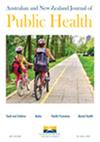5014名澳大利亚青少年中非传染性疾病和发育状况的流行情况及其与饮食、其他生活方式行为和心理健康的关系
IF 2.4
3区 医学
Q2 PUBLIC, ENVIRONMENTAL & OCCUPATIONAL HEALTH
Australian and New Zealand Journal of Public Health
Pub Date : 2025-04-01
DOI:10.1016/j.anzjph.2025.100225
引用次数: 0
摘要
目标:在澳大利亚青年中,目前对非传染性疾病和发育状况的流行以及与可改变的生活方式行为、心理健康和其他社会人口统计学的联系缺乏了解。本文旨在解决这一差距。方法:澳大利亚青少年(N = 5014, Mage=14.7, SD=0.80)完成一项自我报告调查,评估非传染性疾病/发育状况、性别、社会经济地位(SES)、生活方式行为和心理健康。使用多变量逻辑回归来估计这些变量之间的关联。通过在每个回归模型中加入交互项来研究性别和社会地位的调节作用。结果:45.6%的青少年报告了≥1种非传染性疾病/发育状况。作为女性,消费更多的含糖饮料、超加工食品或酒精、参与更多的屏幕时间、抑郁、焦虑或心理困扰都与至少一种疾病/病症的较高发病率相关(p结论:澳大利亚青少年患非传染性疾病和发育病症的比例相当高,突出了这一公共卫生问题的重要性。对公共卫生的影响:与生活方式行为和心理健康的联系突出了它们在公共卫生方面的潜在重要性,有助于预防和治疗这些常见和新出现的非传染性疾病和青少年发育状况。本文章由计算机程序翻译,如有差异,请以英文原文为准。
Prevalence of noncommunicable diseases and developmental conditions in 5014 Australian adolescents, and their correlations with diet, other lifestyle behaviours and mental health
Objective
Amongst Australian youth, there is currently a lack of understanding of the prevalence of noncommunicable diseases and developmental conditions and links with modifiable lifestyle behaviours, mental health and other socio-demographics. This paper aims to address this gap.
Methods
Australian adolescents (N = 5014, Mage=14.7, SD=0.80) completed a self-report survey assessing noncommunicable diseases/developmental conditions, sex, socio-economic status (SES), lifestyle behaviours and mental health. Multivariable logistic regressions were used to estimate the associations between these variables. The moderating effects of sex and SES were investigated by including interaction terms in each regression model.
Results
45.6% adolescents reported ≥1 noncommunicable disease/developmental condition. Being female, consuming more sugar-sweetened beverages, ultra-processed foods, or alcohol, participating in more screen time, having depression, anxiety or psychological distress were each associated with higher rates of having at least one disease/condition (p<0.01). Sex and SES significantly moderated the associations between some lifestyle behaviours and eight diseases/conditions were examined.
Conclusion
Australian adolescents experience considerable rates of noncommunicable diseases and developmental conditions, highlighting the significance of this public health issue.
Implications for public health
Links with lifestyle behaviours and mental health highlight their potential importance in public health to assist with prevention and treatment of these common and emerging noncommunicable diseases and developmental conditions in adolescents.
求助全文
通过发布文献求助,成功后即可免费获取论文全文。
去求助
来源期刊

Australian and New Zealand Journal of Public Health
医学-公共卫生、环境卫生与职业卫生
CiteScore
4.20
自引率
5.70%
发文量
121
审稿时长
6-12 weeks
期刊介绍:
The Australian and New Zealand Journal of Public Health (ANZJPH) is concerned with public health issues. The research reported includes formal epidemiological inquiries into the correlates and causes of diseases and health-related behaviour, analyses of public policy affecting health and disease, and detailed studies of the cultures and social structures within which health and illness exist. The Journal is multidisciplinary and aims to publish methodologically sound research from any of the academic disciplines that constitute public health.
 求助内容:
求助内容: 应助结果提醒方式:
应助结果提醒方式:


